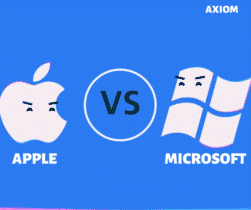Over the years, I have been asked repeatedly what computer type is best: Apple or Windows. My reply until recently has been this: Both products have clear pros and cons that make their value shine based on how you intend to use them. For Apple its strength was the fact you could count on most of the products they offered having the latest hardware with an innovative design that enhanced its abilities and because the hardware was cutting edge it was understandable that their cost was higher than most Windows computers in the same class. Apple typically lasted longer than its Windows counterpart adding to the value, but this has changed over time which I will highlight later in this article. When you add the more media-friendly operating system from Apple it made for a very powerful one-two punch that made using a Mac for home and marketing/music hard to resist. Apple piled on tighter integration with their iPod and iPhone products making their offering very tough to beat.
Years ago, when you looked at the Windows equivalent offerings in the All-n-One and laptops arena, they were restricted by trying to meet a certain price point. This meant most products were cheaper but had slower hardware with mediocre design aesthetics at best. Couple that with almost no real media support for videos and photos and you end up with Windows relegated to the business side of things.

Part 1
This first post will be focusing mostly on the hardware the two products are built on. Originally, when Apple computers were in full swing, the processor that powered the whole system was different from Windows. In 2006 Steve Jobs announced that Apple would be transitioning to Intel processors, which were the major players in the Windows market. This created a unique situation where now Apple and Windows could be directly compared since they would be on the same hardware. To make sure this comparison would not be an issue Apple wisely picked equipment that was cutting edge and at the same time helped validate its higher price. This trend continued for years allowing users to purchase Apple equipment with confidence, since most Apple computers could last 5-6 years compared to 4 years for Windows. Sadly, this is no longer the case. Apple’s iMac product line ran on 7th Gen Intel processors that were released back in 2016, until they finally updated earlier this year. So, for two years, many unsuspecting people shelled out top dollar for these iMacs running on cheaper/slower processors. Even as recently as 2019, some models of the iMac line still offered a traditional spinning disk, instead of solid state. This is a huge bottleneck to performance.
Hardware
At this point, hardware from Microsoft, ASUS, Sony, Dell, HP, Acer and Lenovo offered equal hardware for a cheaper price or even faster with the same price. With that being the case why are so many people still buying Apple computers when they have obviously lost their edge on the hardware arms race? Two big reasons drive this, Apple’s incredible marketing machine and their operating system is still very solid and caters well to the home user, graphic design and music industry. This backed by Apple’s dominance of the phone market that drives people more to their computers are keeping them going. Apple likely can’t sustain this and it might shock people to hear that Apple only makes up just over 7% of all PC sales each year. If they do not continue to make use of the latest generation of processors, they will start losing ground and if an economic downturn happens, people want to make their dollars go further making Apple an even tougher sell.
What’s Next?
In the past, we (Axiom) have been agnostic to which brand a client picked when it came to Apple vs Windows; but at this point, we can’t in good conscious recommend Apple to our clients, unless the case really demanded they pay a higher price to get the Apple operating system. This opens another point that we will dig into with our next article. This is the Apple operating system. Back in 2007 – 2012, the cadence of how fast they released a new operating system was slower, but it has now increased to at least once a year. Why is that significant? Each release of the operating system takes more and more resource of the laptop and gives the user less to use. This eventually make the device almost unusable. I don’t’ believe this is by accident either.
We will get into this topic in much greater detail in our next installment. Until then, as always, reach out to us if you ever have any questions at all.